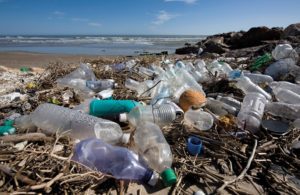
I am sitting outside on my patio as I write this, listening to an array of songbirds singing while my neighbor mows his grass.
Forty-eight years ago today, the people of the United States got together for the first Earth Day celebration. One of the driving forces behind that original celebration was the book Silent Spring by Rachel Carson. She predicted that the sounds of birds singing would be silenced if we didn’t stop using pesticides that were killing birds before they even hatched.
Over the next few years, those pesticides were banned and bipartisan support in Congress passed the Clean Water Act, the Clean Air Act and created the Environmental Protection Agency. All were signed into law by a Republican president.
An issue that rivals pesticides killing birds is the amount of plastic in the ocean.
You have probably seen stories or viral videos showing marine animals tangled in plastic or dead from ingesting it.
“Plastic has been found in more than 60% of all seabirds and in 100% of sea turtles species, that mistake plastic for food. And when animals ingest plastic, it can cause life-threatening problems, including reduced fitness, nutrient uptake and feeding efficiency—all vital for survival,” according to the Ocean Conservancy.
According to the website Plastic Oceans “We are now producing nearly 300 million tons of plastic every year, half of which is for single use. More than 8 million tons of plastic is dumped into our oceans every year.”
There is also a lot of science that indicates that microplastics are in our bodies, accumulating with every drink we take. Even filtered and processed water.
“Foresight Future of the Sea” a report from the UK Government Office for Science said our oceans have seen “unprecedented change as a result of direct human activity and climate change.”
The report found that 70% of marine litter is non-degradable plastic which is projected to increase threefold between 2015 and 2025.
Even when it is recycled, plastic cannot be turned back into another plastic bottle. Plastic is too stable for that. It is turned into pellets and used for other things like fiber fill and insulation. The problem is only about 28 percent of bottles are recycled.
An article in Forbes indicates that “globally humans buy a million plastic bottles per minute.” And that “over half a trillion plastic bottles will be sold in 2020.”
A report from the Ellen MacArthur foundation (downloadable PDF) estimates that by 2050, there will be more plastic in the ocean, by weight, than fish.
Living inland, away from the coast, it is easy to think that the problem doesn’t apply to me. But I see tons of plastic floating down the river after every hard rain and collecting at every lock on the river, only to be flushed on downstream. Eventually, it will make it to the ocean. It takes 400 years for that plastic water bottle, or single-use straw, to degrade.
Protecting the environment and making sure birds have trees to roost in, we all have clean water to drink and good air to breathe drink isn’t hard to justify. The same should be true for everything that swims in the oceans.
We rely on the oceans for food, recreation and the very air we breathe. It is time for a new Earth Day call, like the one brought about by Carson, to reduce single-use plastics and keep them out of our oceans.